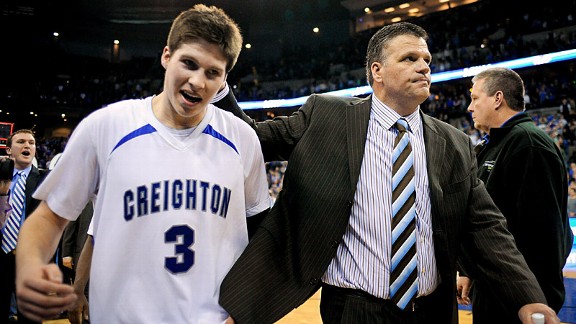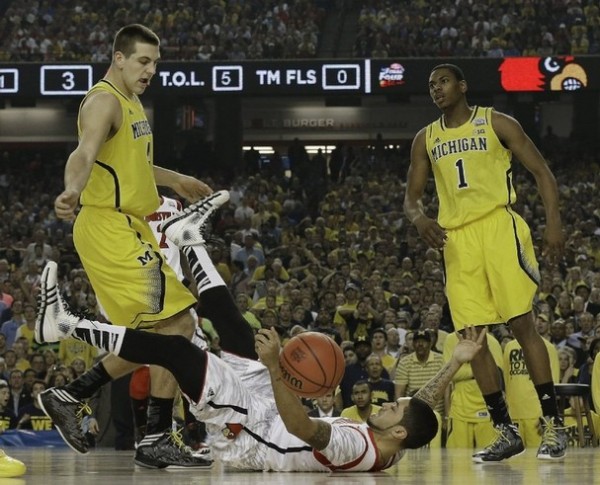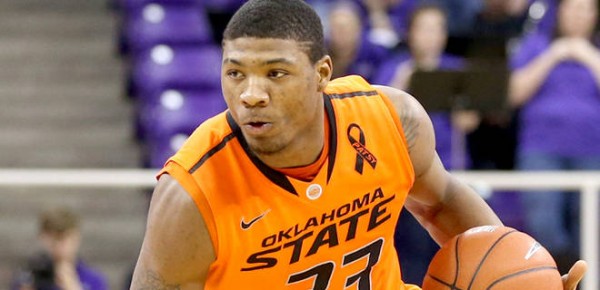Breaking Down This Year’s Five Biggest NBA Draft Refusals
Posted by Chris Johnson on April 29th, 2013Chris Johnson is an RTC Columnist. He can be reached @ChrisDJohnsonn.
The NBA Draft deadline can be a harrowing time for programs, coaches and their ever-vigilant fan bases. Player defections – particularly those of the lottery breed – not only control the fates of specific teams, they create massive rippling effects on college basketball writ large. Based on who does or doesn’t make their talents available to the most exclusively competitive sports league in North America, college basketball takes on a certain median composite talent distinction. Last season, that measure was low, and fans of all kinds made sure to scream and wail and cry foul about the dearth of “elite talent” and the oncoming barrenness of prospective upside on this year’s draft boards. “No dominant team” was a meme raised just as frequently, and by the end of the season, when two of the nation’s most talented teams navigated the predicted upset-laden waters of the NCAA Tournament and staged an epic final game – and when the nation’s “dominant team,” Louisville, actually won the whole thing – the conversation quickly turned to 2013-14.

With McDermott back, Creighton has every reason to be excited about its move into the Big East (Getty Images).
That brings us to Sunday’s NBA Draft deadline, the real draft deadline, the one that actually forces players to make decisions about their professional futures, rather than the teethless NCAA-imposed early date created for the supposed benefit of coaches’ scholarship and recruiting calculations during the recruiting spring signing period. There were some notable departures this year, National Player of the Year award-sweeping point guard Trey Burke chief among them, but all in all the final count leaves college basketball with an immensely intriguing selection of returning players that – when mixed with one of the most highest-touted recruiting classes of the past 10 or so years – should produce a general quality of play that far exceeds last season’s occasionally-ugly level. I’ve come up with five players (or pairs of players) whose reappearance in the college ranks will contribute most directly to making this season not only hugely appealing for its freshmen stars – as is often the case in the one-and-done era – but experienced and deep and seasoned enough to produce a boundlessly exciting pool of players and teams. We are going to see a host of really good returning players in college basketball next season, and unlike last year, many of these guys won’t come off as totally unfamiliar. There’s some star power here – as in not in the NBA. Rejoice.
Doug McDermott – Creighton. The end of last season, brought upon by a Round of 32 NCAA Tournament loss to Duke, ushered Creighton into a programmatic transition: Beginning this season, the Bluejays will become members of the new Big East. They leave behind a good but measurably inferior Missouri Valley Conference, and the step up in competition promises to be fierce. It would have been a completely reasonable move for McDermott to stare down the present, understand the rigors of a more challenging conference schedule, the increased defensive attention from better athletes across a larger number of quality teams, and cut loose with program and father-coach after a successful three-year career. It would have made the most possible sense.
Nothing McDermott does when scoring and spinning and craftily finishing at seemingly impossible angles makes actual sense, MVC defenders will most definitely agree, so McDermott took the circuitous route again. His return obviously makes Creighton a team to watch in the new-look Big East. It also gives McDermott a chance to showcase his diverse skills against more rigorous opposition, which was probably the biggest knock on McDermott’s NBA merits going into this year’s pre-draft process. Better yet, college basketball gets one of its most recognizable stars to hang around for another season, plus the added bonus of watching McDermott chase three-time first-team All-American status, a feat not accomplished in more than three decades.
Adreian Payne, Gary Harris – Michigan State. If Kentucky, as expected, lands top-rated 2014 recruit Andrew Wiggins, prepare for a summer-long Big Blue coronation. Many will be quick to hand the Wildcats next season’s title, and understandably so – six (or seven) McDonald’s All-Americans and a coach with the means and the experience to mold them into something greater (if that’s even possible) than the sum of their lottery-bound parts are pretty safe reasons to feel good about your national championship chances. The season will begin as a “who can beat UK” affair, and the question will linger on right up and into March.
One team worthy of discussion is Michigan State, but their candidacy for designated UK-dethroner would have been totally moot if not for the NBA evasions of point guard Gary Harris and forward Adreian Payne. Harris is a long and athletic point (draftspeak at its finest!) with a developing offensive game and a precocious feel for how to handle the backcourt obstacles in the most rugged league in the country. Payne was always a project, an athletic specimen with bushels of “what if?” upside, that just this season turned into a polished finisher and self-realized multi-purpose star. Paired alongside forward Branden Dawson, who spent much of this season working back from a torn ACL, MSU has enough size and skill on the low block to match the Wildcats and then some. The Big Ten championship runs through East Lansing this season; Harris and Payne guaranteed as much.
Marcus Smart, Oklahoma State. When Smart announced his return to Oklahoma State for a second season, the reaction was curiously paternalistic. Everyone, it seemed, had their ideas about how Smart was compromising his money-earning potential, how an unlucky injury could harm his draft slot next season, how the loaded 2014 recruiting class and a year of NBA draftnik-scrutiny would push him out of the lottery. All of that is completely discretionary – if you want to comment on a teenager’s ability to weigh the merits of enjoying the benefits of a quality college education and refining his game in the amateur ranks against a professional lifestyle, that’s your prerogative. What’s rather clear, what few were willing to point out, is that Smart’s return is really good thing! College basketball is a better place with Marcus Smart in it, then out of it, promise!
Television viewers will be pleased, but the rest of the Big 12 won’t be so keen on seeing a 6’4’’ bulldog of a lead guard penetrating and dishing and defending and making OSU every bit a real challenger in a fuzzily weak Big 12. Kansas loses Jeff Withey and Ben McLemore, Kansas State is down, Oklahoma will bid adieu to most of its veteran components. Baylor (more on the Bears below) is the most obvious competition, and Bill Self has long since proved the silliness of doubting Kansas’ yearly conference title potential, but Smart (along with hot-and-cold scoring wing Le’Bryan Nash, who also spurned NBA riches for another run in the Big 12) makes the Cowboys an almost surefire NCAA Tournament lock with conference hardware aspirations to boot.
Shabazz Napier, UConn. Keeping track of UConn last season was a litmus test of basketball affection in its purest form. Allow me to explain. If you like good basketball – if you enjoy the game for the game itself, no strings attached to postseason incentives – you watched a depleted UConn team with an interim coach turn into one of the country’s toughest and most visibly chip-on-shoulder gritty outfits on the country. The Huskies quietly put together a very nice season without anything in the way of NCAA Tournament incentive to fuel their motivational motor. With the Huskies’ Academic Progress Penalty rate penalty wearing off for the upcoming season, UConn can take last year’s spunk and turn it into a tangibly NCAA Tournament-gratifying season. The Huskies can make something of their regular season efforts.
The biggest reason they will, as we learned just this weekend, is the return of guard Shabazz Napier. One year after one of the most disappointing post-national title seasons in recent memory – Napier, Jeremy Lamb, Andre Drummond and company never came close to what their massive hype portended – Napier was the best player and biggest leader in Kevin Ollie’s inaugural season. He posted a 115.3 offensive rating in identical 24 percent usage and shooting rates, and when you look at UConn’s returning contingent – basically everyone, save Holy Cross transfer R.J. Evans – the Huskies suddenly look like one of the surest things in a very unsure American Athletic Conference.
Glenn Robinson III, Mitch McGary – Michigan. Even in defeat, the Michigan team that gave Louisville everything it wanted for 40 minutes in the national championship game was one of the most fun and enjoyable youthful title participants to reach that stage in quite some time. Like the Anthony Davis-led Kentucky group of two seasons prior – though only sporadically compared in this context – the Wolverines started three really talented freshmen, mixed in a few solid contributing veterans and an intangibly forceful team unity that powered UM to its first national final since the Fab-Five glory days. Losing Burke was less a question than an assumed conclusion, and McGary and Robinson were likewise expected to bolt. The foundation of Michigan’s long-awaited hoops resurgence might well have made a brief one-year appearance on the national stage, come one game short of cutting down the nets, and that would have been that.

The Great Lakes State will host one of next season’s best rivalries, thanks in part to McGary and Robinson III’s decisions to eschew the NBA (AP Photo).
That’s not to say the Wolverines would have reverted back to their mid-aughts Big Ten mediocrity – but they are about 85 light years (which is a unit of measurement with has no practical application beyond NASA, or the movie “Spaceballs”) more optimistic about this season with the knowledge that their two best post pieces, McGary and Robinson, will return for at least one more season. I touched on Michigan State’s apparent Big Ten front-runner status heading into next season, and that still stands fundamentally true, but the Wolverines aren’t all that far off. No one can match McGary’s incessant glass-cleaning and rim-running motor, and Robinson is a limitless bundle of athletic potential. Sign me up for Michigan-Michigan State at the Breslin Center next season. If that doesn’t stimulate your inner-college hoops endorphins, I don’t know what will.
Honorable Mention
- Isaiah Austin, Cory Jefferson – Baylor. Frontcourt pairings with this much length and versatility and, a personal and Jay Bilas draft-description favorite, “wingspan” (bottoms up!), aren’t standard practice for any college hoops era, let alone the diffuse one-and-done age. If Austin can add some needed toughness to his legitimate guard-made tool box and Jefferson can sustain his 128.1 offensive rating in bigger minutes, the Bears will be a frontcourt match-up nightmare no matter who lines up to stop them.
- Russ Smith, Louisville. Immediate post-title projections riding on the assumption Smith would leave for the draft had Louisville tabbed as one of the most likely national championship competitors for 2013-14. Smith elevates the Cards’ title hopes, and because Louisville brings back the lion’s share of their championship roster, with Peyton Siva and Gorgui Dieng the only major detractions, the continuity and established rotational trust will be in place for a seamless transition into another championship run. Besides, someone needs to get in Kentucky’s way, right? Who better than a Smith-fortified Cardinals group? Bluegrass rival Louisville is a local, and very credible, threat.
Some Others Who Missed the Cut: Patric Young, Florida; Willie Cauley-Stein, Alex Poythress, Kentucky; Kyle Anderson, UCLA; Jahii Carson, Arizona State; James Michael McAdoo, P.J. Hairston, North Carolina; Jarnell Stokes, Tennessee; Dwight Powell, Stanford; CJ Fair, Syracuse













































